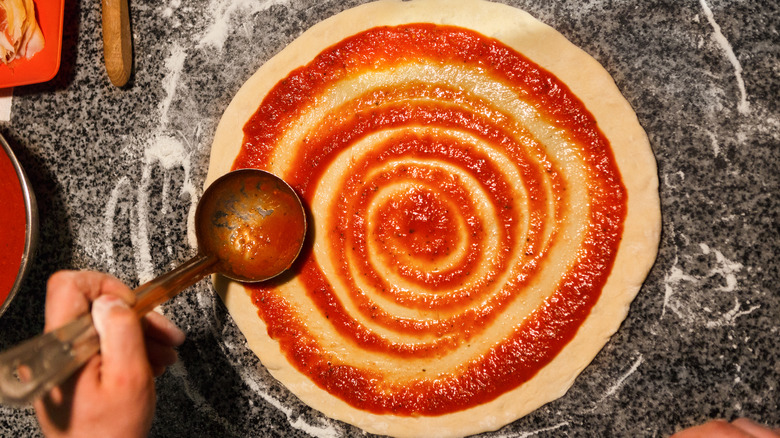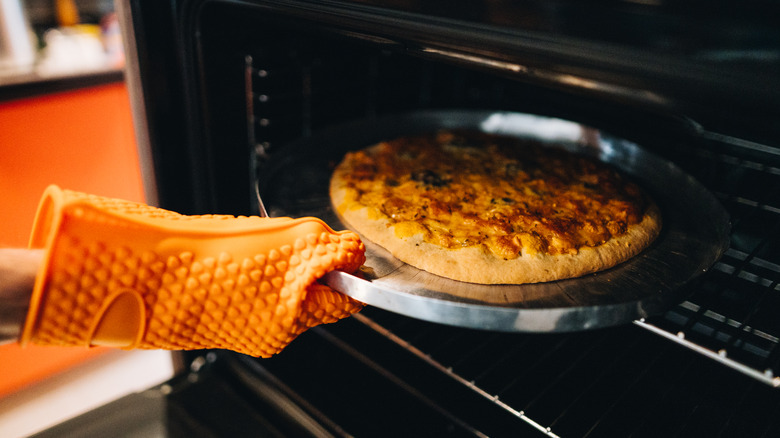The Common Pizza Mistake That'll Leave You With Soggy Dough
Pizza is famously easy to get via delivery. But if you're making your own pizza, it's probably because you want a more elaborate pie that's cooked to perfection. However, if the end result is soggy, your pizza was probably not cooked to perfection. Soggy pizza dough can be a big problem for first-time pizza chefs, because aside from tasting (and often looking) gross, it's a clear sign that your pizza is undercooked. Pizza crust needs to be dry and crispy before it's ready to eat.
So what happened? There are a few things that cause soggy crusts, but the most common issue is simply that the oven wasn't hot enough. For pizzas, assuming you're using a normal kitchen oven, the ideal range is 450 to 500 degrees Fahrenheit. If you're working with a pizza oven, the pizza will be finished much more quickly since it's cooking at around 700 to 800 degrees Fahrenheit, although it needs to be rotated every 30 seconds so that it's cooked evenly. In any case, even though pizza tastes pretty good cold, it always needs to be properly cooked first. If you're using a regular oven, make sure you give it enough time to heat up to 500 degrees Fahrenheit, or as close to that temperature as possible.
Turn up the heat
There's another factor that makes all of this a little more complicated: Because of how ovens work, it's possible to cook the top of your pizza more than the bottom. Which oven rack are you using to bake your pizza? The different racks in your oven — top, middle, bottom — access different levels of heat because of the way heat moves. Most ovens heat from both the top and the bottom, but heat rises, so the top rack is nearly always the hottest.
But despite that, the bottom rack is usually considered the standard when it comes to pizza. This is because baking sheets can sometimes interfere with cooking the pizza's bottom, or even transfer a cooler temperature to the dough if the sheet is cold. The bottom rack helps you cook the dough thoroughly without burning up the toppings.
It also helps to invest in a pizza stone if you're a serious aspiring pizzamaker. A pizza stone is a flat ceramic slab specifically designed for helping pizzas cook correctly at lower temperatures: They retain heat more evenly than baking sheets (especially if you preheat the pizza stone) and they're porous enough to let water out from more damp sections of dough.
And watch your tomatoes
There are other things to keep in mind that can also make your pizza soggy. Watery toppings or sauce can be another common pizza-killer, and that's why you want your pizza sauce to be smooth enough to spread but still a little thick. Even then, don't add too much sauce either. Be especially careful if you're making a sauce-heavy pie like Margherita pizza, which is different than regular cheese pizza and often needs a substantial amount of tomato sauce and mozzarella.
Watery toppings like vegetables are also an issue for dough, because lots of veggies like peppers and onions are mostly water (the former is 92% water and the latter is 89%, in fact). Load up too many, and all that water will find its way into the dough.
Now, a lot of this mostly only applies if you're cooking your pizza completely from scratch. If you're working with a store-bought pizza, those come pre-cooked and the box usually tells you to set your oven to a much lower temperature. But cooking a pizza entirely on your own is worth the extra hassle, so long as you and your oven are up to the challenge.


